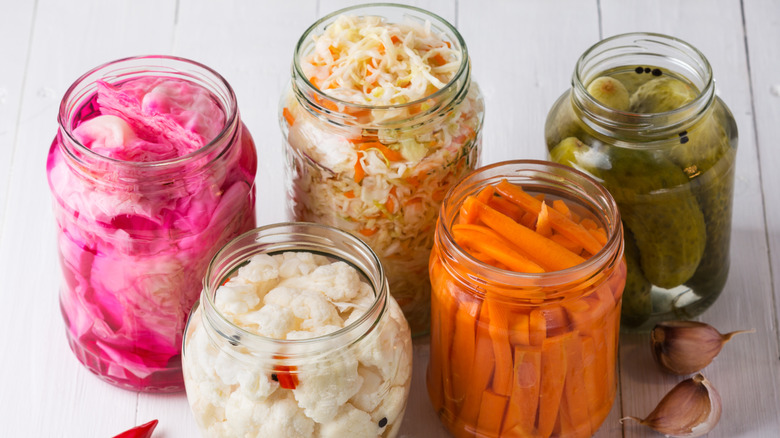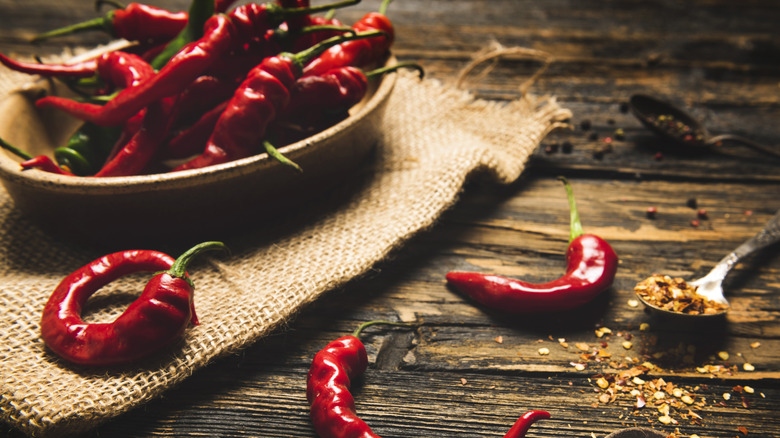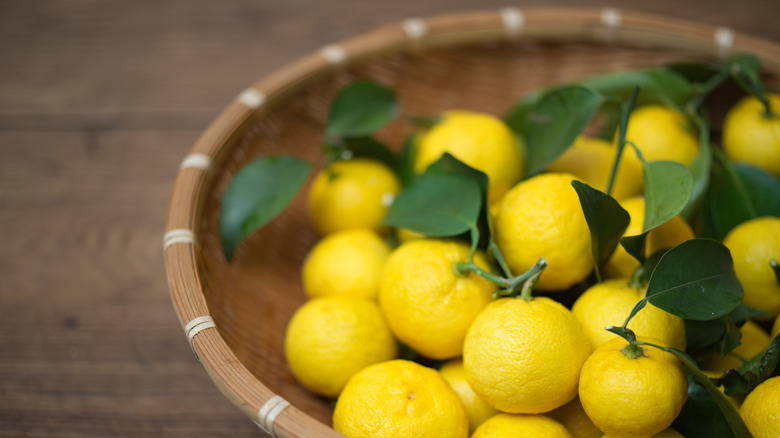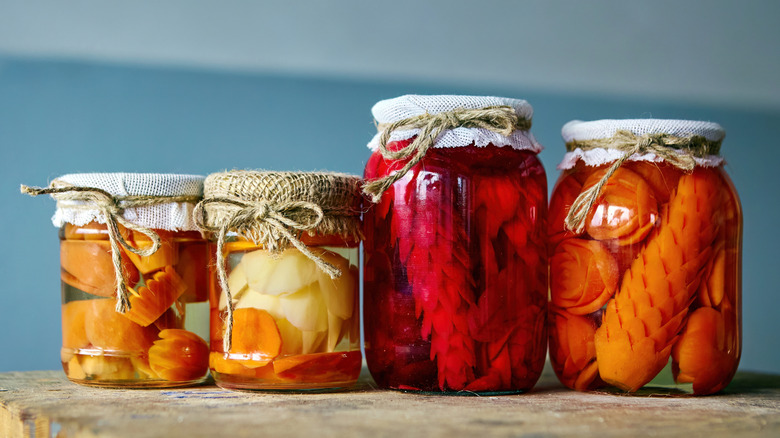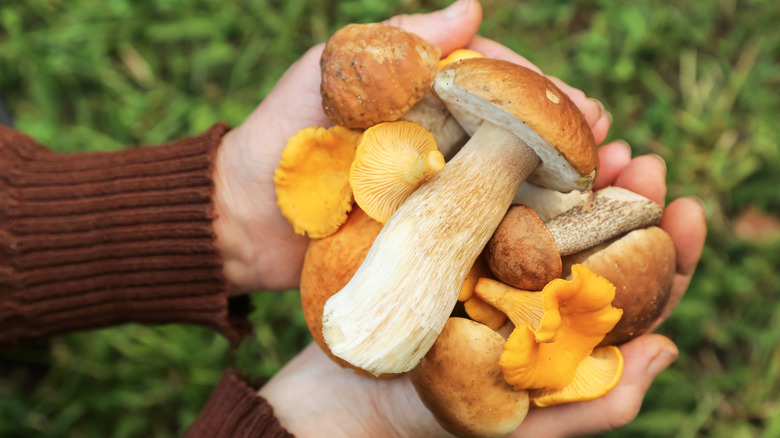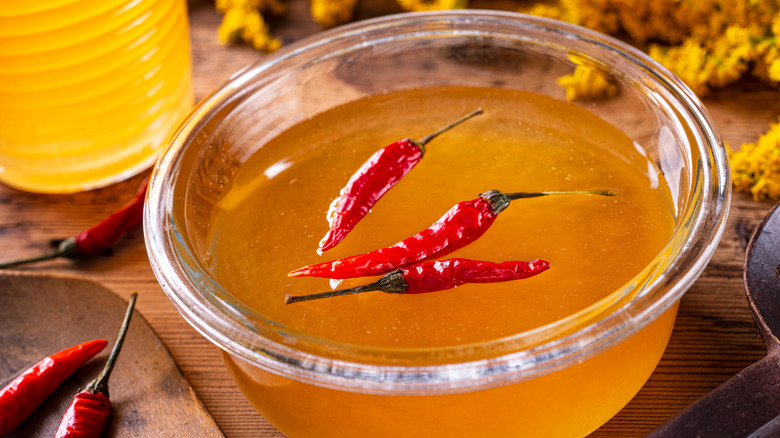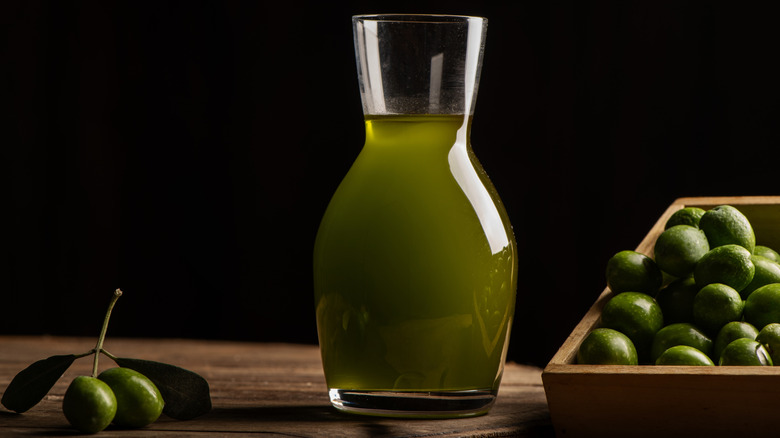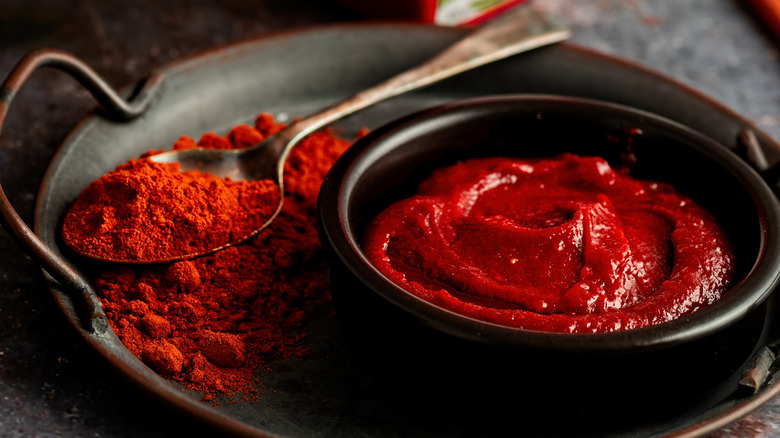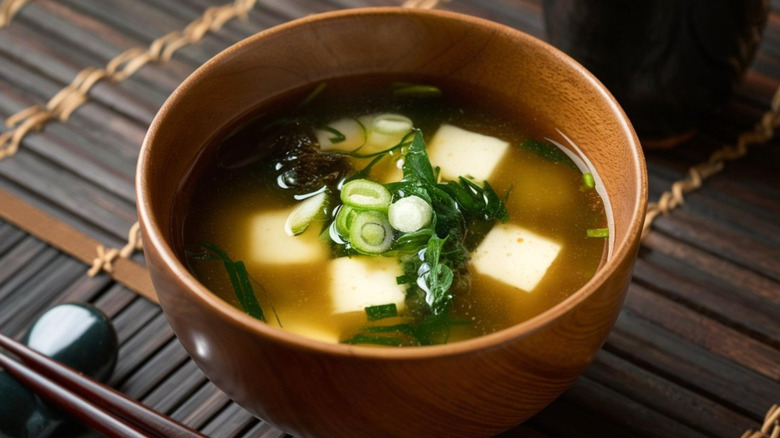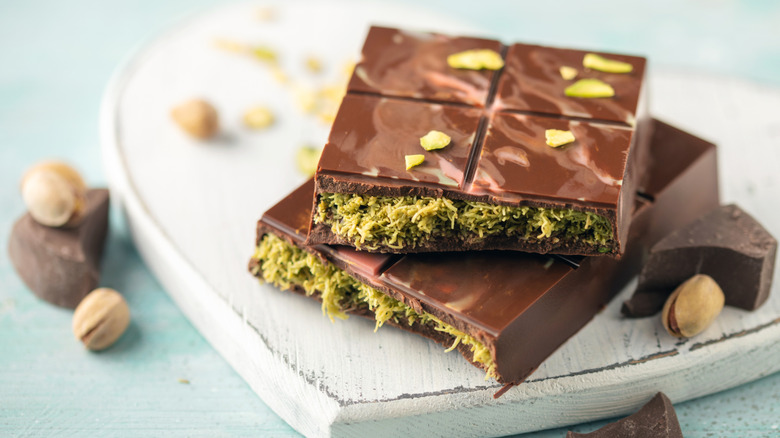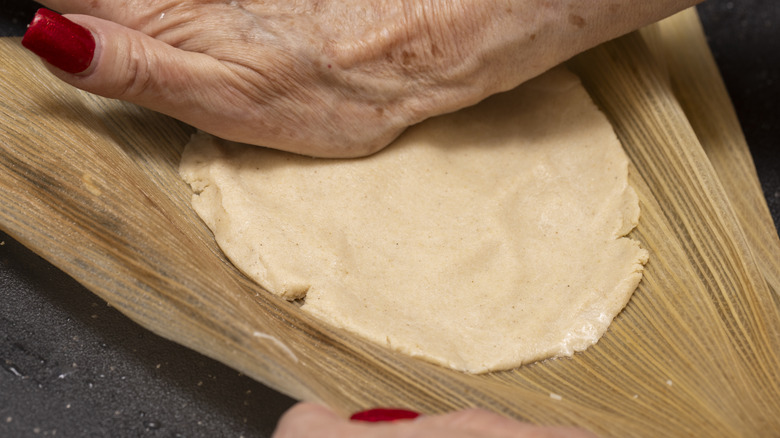12 Ingredients Everyone Will Be Cooking With In 2025
Food fads come and go. There are already food trends from the past decade we've forgotten about – like when kale was in everything or when we were all eating rainbow bagels. But even if they aren't around forever, it can be fun to keep up with the latest trends in food and cooking. We've done our research to predict the ingredients everyone will be cooking with in 2025.
Some of these — like gochujang and hot honey — have been increasing in popularity for some time and are about to become mainstream. Others are fancier versions of things you might have already been using, like high-end olive oil and jarred beans over canned. But, wherever these ingredient trends are coming from, prepare to see them everywhere in 2025 — including in your own kitchen.
Although we can't know for sure which ingredients will end up being the stars of the year and which will fade into obscurity, we can make some educated assumptions. We've looked at trends in sales, in supermarkets, and the food service industry, as well as examining ingredients that have been on the rise but haven't yet gone viral. These are the foods we think people will be cooking with this year.
1. Peppers
Peppers are likely to be big in 2025. Now, you might be imagining bell peppers but there's way more to explore. Alongside these and other sweet peppers, like pointed varieties, there's a whole world of chile peppers. It's likely that people will not only be revisiting bell peppers this year, but also leaning into new chile pepper varieties that they haven't tried.
Both fresh and dried peppers are used in a range of dishes, from the dried chiles in a birria recipe to fresh padron peppers charred in a pan and eaten whole. This might be the year that you become a pepper nerd and learn about all the different varieties from mild ancho chiles to more fiery varieties, like Scotch bonnets.
When using dried peppers, there's a little more work involved, because you need to grind them into powders or rehydrate them before use, but it's still fairly straightforward once you get the hang of it. Fresh peppers you can just dice or slice and sauté in a range of dishes. Plus, there's more you can do with peppers, such as pickling them or turning them into hot sauce.
2. Yuzu
You may have heard of yuzu already, but 2025 is the year it's set to get big. Currently, it's the kind of thing that you'll occasionally see as an ingredient on a Japanese menu or find flavoring an artisanal seltzer, but we think it's about to become a more common ingredient used by home chefs.
But, maybe you're still wondering what this mystery ingredient is. Yuzu is a citrus fruit native to East Asia, with a bright, tangy flavor that's a mix of lemon, orange, and grapefruit. It has a bumpy yellow skin and its juice and zest are used, similar to lemon or lime. It's widely used in Japanese, Korean, and Chinese cuisines, but is only starting to make it to the U.S.
You'll find all kinds of dishes that use yuzu. It's used in both sweet and savory recipes, so you might find it in anything from cheesecake to traditional Japanese ponzu dipping sauce. You can even use yuzu in pasta sauce. It can be a little tough to find outside of well-stocked Asian supermarkets but it's worth searching for.
3. Artisanal pickles
Sometimes product trends aren't about innovating and trying new ingredients but rather upgrading an old favorite. Artisanal pickles are one such example and are set to be on the rise this year. The market for artisanal pickles is expected to grow by over $4 billion by 2030, according to Business Wire. So, you can get ahead of the trend by stocking your pantry with them now.
These pickles can cover a lot of ground. You have old classics like dill pickles and bread and butter pickles, as well as spicy pickles and other flavors. But there's also a move beyond pickled cucumber, as well. You might find more unusual ingredients being pickled, such as mooli radish, garlic, or pineapples. The best of these are often made in small batches by independent producers. Look for them at farmers markets or small delis.
If you want to incorporate artisanal pickles into your repertoire, there are so many ways to use them. They're great in sandwiches and salads or tucked into burgers. But, there are so many ways to cook with pickles rather than using them as a raw ingredient. You can batter and fry them, use them in soups, cook them on top of pizzas, and stick them in savory pancakes — and that's just the start. Their flavor may mellow when cooked, which can be a pro or a con, depending on your preferences.
4. Mushrooms
While mushrooms have never exactly gone out of fashion, they're expected to be especially trendy this year. One of the reasons they're getting so much hype at the moment is because of their nutritional values and health-related properties. People are talking about so-called functional mushrooms – such as reishi and turkey tail — which are said to be packed with antioxidants and have a range of health benefits.
While functional mushrooms are more often found in drinks and supplements, we expect them to be used more across the board in 2025. This interest in mushrooms for health is likely to spill over and we'll see more of them on restaurant menus and people increasingly cooking with them at home. It's also linked to an increased interest in plant-heavy diets.
It's likely that home cooks will start expanding beyond the basics like button and cremini, working with more types of mushrooms than ever before. Popular choices may include meaty king oyster mushrooms, which can be shredded or cooked like scallops; petite, quick-cooking enoki; richly umami porcinis; or earthy, complex chanterelles. Mushrooms are great in a huge variety of dishes from pastas and risottos to tacos and steaming bowls of ramen. Their versatility is a big selling point, as keen cooks can experiment with them in many ways.
5. Hot honey
If you're up on the latest food trends, you've probably already noticed hot honey. But this sweet-spicy goodness is set to be even more visible in 2025. Expect it to be drizzled all over pies at your favorite pizzeria, used to glaze wings, and served as a dipping sauce for everything from tots to halloumi fries. This means it's also the perfect time to start using it at home if you aren't already.
But first, you might still be wondering what is hot honey? Essentially, it's just honey mixed with chiles or other spicy ingredients to give it a kick. It has all the sweetness of honey with fiery notes. It might seem like it's the new kid on the block, but actually it's been used in Brazil for hundreds of years, both for culinary purposes and in traditional medicine. While you can buy it in stores, it's also easy to make yourself. Either, the quick way — by mixing hot sauce and honey together — or the longer way, which involves steeping chile peppers in honey until it reaches your desired spice level.
Once you've got your hands on hot honey, it's great in so many recipes. Sure, you can use it as a drizzle or a condiment, but it can be used for so much more than that. It's the perfect ingredient in glazes and marinades, bringing sweetness and spiciness while also helping ingredients to get sticky and caramelized. Outside of savory applications, it's tasty in desserts and drinks.
6. High-quality olive oils
In 2025, we expect to see people opt for higher quality olive oils. This isn't going to be your everyday olive oil for roasting and frying, but rather a special treat for finishing dishes — drizzling it on pasta dishes or swirling it in soups. While high-end olive oil can seem like a splurge that you aren't willing to shell out on given rising food prices, think of it more as a nice bottle of wine. It's a little bit of luxury — and one that will last you longer than a nice pinot noir.
One of the driving forces behind this is that your basic supermarket olive oil is probably fake. Fraud is rife in the industry and what's sold as extra-virgin olive oil is sometimes cut with other cheaper oils. News has also hit that olive oil prices are set to come crashing down. You'll no longer have to spend $20 on a bottle of very average grocery store olive oil, which frees up more money to spend on something nice.
What's more, many folks have begun to realize that not all olive oil is created equal. Much like artisan coffee, there's a difference between the flavor of olive oil from different growing regions, olive varieties, altitudes, and more. So, it can be worth seeking out high-end varieties. Don't be surprised if you end the year with a pantry full of good bottles. Just don't hold onto it like you would wine — olive oil is at its best consumed within 12 months.
7. Gochujang
Gochujang is basically the next sriracha. It's already on its way up, having gone from relative obscurity outside of South Korea to being an ingredient that most people who are interested in food and cooking have heard of. In 2025, you can expect to find gochujang hot wings on menus all over the country and gochujang mayo served with burgers and fries.
So, if you haven't already, now might be the time to pick up a tub of gochujang from your local grocery store that stocks Korean ingredients. Its blend of sweet and spicy is appealing to many folks, but it also has umami notes and a slight complex funk to it from fermented soybeans. This sets it apart from other hot sauces and chile pastes on the market. It has a thick consistency, so you can't just drizzle it over foods like you would with hot sauce but it's great mixed with other ingredients.
You can add it to all kinds of dishes, like soups, stews, and curries, from traditional Korean dishes to a basic pot pie filling. It's an easy way to add a boost of spice and umami flavor in one go. It's also a key ingredient in homemade hoisin sauce, giving it more richness and complexity than the store-bought kind. You can also mix it with mayo to make a dipping sauce or even dollop some in a boxed mac and cheese while cooking it up. The options are seemingly endless.
8. Seaweed
Seaweed is likely to make waves in 2025, and it's easy to see why. Edible seaweed has been a staple in many Asian cuisines for centuries. However, it's now gaining traction worldwide as people look for new ways to eat healthily and sustainably. From sushi rolls to seaweed snacks, it's becoming more common to see these ocean greens on menus and in grocery stores — and we predict you'll be cooking with it this year.
You can find many varieties of seaweed, like nori, wakame, kombu, and dulse. Each has its own flavor and culinary uses. Nori is perfect for wrapping sushi or crumbling over rice, while wakame is a popular addition to soups and salads. Kombu is used to make dashi, the base for many Japanese broths — but you can also use it to make beans less gas-inducing, since it breaks down their starches during cooking.
Seaweed's eco-friendly nature is another reason for its growing popularity. It requires no freshwater, fertilizer, or land to grow and can even help combat climate change by absorbing carbon dioxide. In 2025, expect to see seaweed in everything from pastas to plant-based meats as chefs and home cooks alike embrace it. There can be a learning curve when you're starting to cook with it, but don't let that put you off. Start with some solid recipes and work from there.
9. Pistachios
Could 2025 be the year of the pistachio? You might buy them in their shells, salted and ready for snacking on, or perhaps pistachio ice cream is your go-to, but we predict they're going to be used in far more ways this year. Their rich nuttiness, slight sweetness, and vibrant green color makes them a beautiful addition to so many dishes.
This uptick in interest likely comes from the Dubai chocolate bar that's been doing the rounds online. It's filled with pistachio and crispy knafeh pastry. Out and about, you might see pistachio in croissants and other pastries, chocolates, cakes, and more. But, as with most food trends, it will extend to the home kitchen too.
While whole pistachios are great in a lot of recipes, pistachio cream is ideal for desserts. This Italian delicacy is made from ground pistachios, along with other ingredients like sugar, butter, and milk or cream. It's ideal for making fillings for pastries, sandwich cookies, truffles, and other sweet treats. But there are also savory pistachio recipes, such as pesto, gremolata, and risotto.
10. Sour cherries
Sour cherries are having a moment, and 2025 is set to be the year we find them in kitchens everywhere. While the sweet versions have long been a staple in desserts, sour cherries are finally having their turn. Their tartness means they're versatile and can go beyond sweet treats. From cocktails to savory sauces, you might find sour cherries popping up everywhere this year.
The balance of sweetness and acidity is part of their appeal, adding depth to a range of dishes. You might make a sour cherry reduction to go with your choice of protein or a sharp, tangy chutney that you can serve alongside a cheeseboard. But, of course sour cherries are great in baked goods too. Their tang offsets richer ingredients like chocolate or vanilla. Whether you're cooking savory or sweet, there's a place for them in your repertoire.
You'll find them fresh during their short summer season, but they're almost as good frozen or jarred. This means you can always have them on hand to experiment with or liven up a dish. There are some traditional recipes — like Black Forest cake — that use sour cherries, but we think they'll be seen way beyond these confines before the year is out.
11. Masa
It might seem strange for masa to be a food trend, considering it has been used in Latin American cooking for thousands of years. However, there's always time for trends to come back around. If you've been paying attention, you might have spotted masa-based recipes more and more on menus. There are even restaurants exclusively focused on masa. But in 2025, we expect it to be a more common ingredient to use in home cooking, as well.
Maybe you're still wondering what masa is and how to use it. Masa is a dough made from ground corn. However, at home, it's usually made by mixing masa harina (a type of flour made from corn) and water. Traditionalists and some restaurants might grind their own corn, but it's not practical for the average home cook.
Once you've made your masa, you can use it in various ways. The most common include forming it into corn tortillas, arepas, and tamales. You can experiment with other options, though, such as masa pancakes, sweet masa cakes called gorditas de piloncillo, chochoyotes, and more. Once you have masa down, there are many creative ways to use it.
12. Ube
Ube is a vibrant purple yam from the Philippines with a sweet, nutty flavor that makes it a versatile choice for all kinds of dishes. And it's poised to take 2025 by storm. While ube has long been a staple in Filipino cuisine, it's becoming more popular in the U.S. and this is its year. We've been seeing it more on menus in the past year or so and it's going to become a more common ingredient to cook with at home, too.
Its natural purple hue easily transforms dishes without the need for artificial food dyes. It looks just as good in a bowl of ice cream as it does in a layered cake or a trendy donut. This year, you can expect to see ube-infused pastries dominating bakery displays, ube pancakes and waffles gracing brunch menus, and even ube cocktails making a splash at bars. There are all kinds of ways you might use it in baked goods and other sweet treats at home. For instance, you can stuff French toast with ube jam for a sweet, eye-catching filling.
But it's not just about the looks, ube tastes great too. It's subtly sweet with hints of vanilla and coconut. These sweet notes make it particularly popular in dessert recipes, but it's delicious in savory recipes, as well, such as soup, breads, and hummus. In traditional Filipino cooking, ube is often boiled, mashed, and turned into jams like ube halaya, which can be eaten straight up as a dessert or used as a spread.
